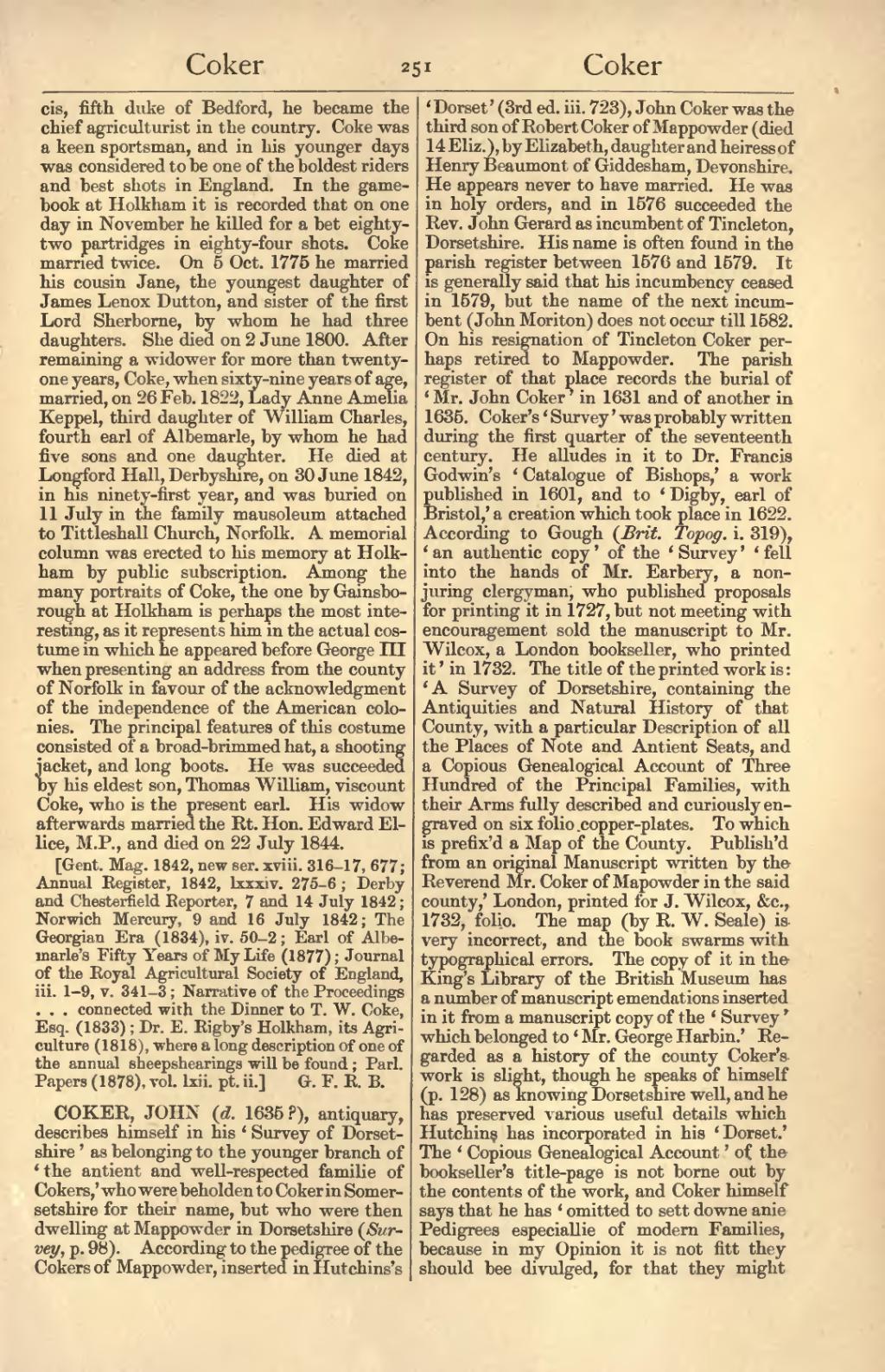cis, fifth duke of Bedford, he became the chief agriculturist in the country. Coke was a keen sportsman, and in his younger days was considered to be one of the boldest riders and best shots in England. In the game-book at Holkham it is recorded that on one day in November he killed for a bet eighty-two partridges in eighty-four shots. Coke married twice. On 5 Oct. 1775 he married his cousin Jane, the youngest daughter of James Lenox Button, and sister of the first Lord Sherborne, by whom he had three daughters. She died on 2 June 1800. After remaining a widower for more than twenty-one years, Coke, when sixty-nine years of age, married, on 26 Feb. 1822, Lady Anne Amelia Keppel, third daughter of William Charles, fourth earl of Albemarle, by whom he had five sons and one daughter. He died at Longford Hall, Derbyshire, on 30 June 1842, in his ninety-first year, and was buried on 11 July in the family mausoleum attached to Tittleshall Church, Norfolk. A memorial column was erected to his memory at Holkham by public subscription. Among the many portraits of Coke, the one by Gainsborough at Holkham is perhaps the most interesting, as it represents him in the actual costume in which he appeared before George III when presenting an address from the county of Norfolk in favour of the acknowledgment of the independence of the American colonies. The principal features of this costume consisted of a broad-brimmed hat, a shooting jacket, and long boots. He was succeeded by his eldest son, Thomas William, viscount Coke, who is the present earl. His widow afterwards married the Rt. Hon. Edward Ellice, M.P., and died on 22 July 1844.
[Gent. Mag. 1842, new ser. xviii. 316-17, 677; Annual Register, 1842, Ixxxiv. 275-6; Derby and Chesterfield Reporter, 7 and 14 July 1842; Norwich Mercury, 9 and 16 July 1842; The Georgian Era (1834), iv. 50-2; Earl of Albemarle's Fifty Years of My Life (1877); Journal of the Royal Agricultural Society of England, iii. 19, v. 341-3; Narrative of the Proceedings … connected with the Dinner to T. W. Coke, Esq. (1833); Dr. E. Rigby's Holkham, its Agriculture (1818), where a long description of one of the annual sheepshearings will be found; Parl. Papers (1878), vol. lxii. pt. ii.]
COKER, JOHN (d. 1635?), antiquary, describes himself in his 'Survey of Dorsetshire ' as belonging to the younger branch of 'the antient and well-respected familie of Cokers,' who were beholden to Coker in Somersetshire for their name, but who were then dwelling at Mappowder in Dorsetshire (Survey, p. 98). According to the pedigree of the Cokers of Mappowder, inserted in Hutchins's 'Dorset ' (3rd ed. iii. 723), John Coker was the third son of Robert Coker of Mappowder (died 14 Eliz.) by Elizabeth, daughter and heiress of Henry Beaumont of Giddesham, Devonshire. He appears never to have married. He was in holy orders, and in 1576 succeeded the Rev. John Gerard as incumbent of Tincleton, Dorsetshire. His name is often found in the parish register between 1576 and 1579. It is generally said that his incumbency ceased in 1579, but the name of the next incumbent (John Moriton) does not occur till 1582. On his resignation of Tincleton Coker perhaps retired to Mappowder. The parish register of that place records the burial of 'Mr. John Coker' in 1631 and of another in 1 635 . Coker's 'Survey' was probably written during the first quarter of the seventeenth century. He alludes in it to Dr. Francis Godwin's 'Catalogue of Bishops,' a work published in 1601, and to 'Digby, earl of Bristol,' a creation which took place in 1622. According to Gough (rit. Topog. i. 319), 'an authentic copy' of the 'Survey' 'fell into the hands of Mr. Barbery, a non-juring clergyman, who published proposals for printing it in 1727, but not meeting with encouragement sold the manuscript to Mr. Wilcox, a London bookseller, who printed it' in 1732. The title of the printed work is: 'A Survey of Dorsetshire, containing the Antiquities and Natural History of that County, with a particular Description of all the Places of Note and Antient Seats, and a Copious Genealogical Account of Three Hundred of the Principal Families, with their Arms fully described and curiously engraved on six folio copper-plates. To which is prefix'd a Map of the County. Publish'd from an original Manuscript written by the Reverend Mr. Coker of Mapowder in the said county,' London, printed for J. Wilcox, &c., 1732, folio. The map (by R. W. Seale) is very incorrect, and the book swarms with typographical errors. The copy of it in the King's Library of the British Museum has a number of manuscript emendations inserted in it from a manuscript copy of the 'Survey' which belonged to 'Mr. George Harbin.' Regarded as a history of the county Coker's work is slight, though he speaks of himself (p. 128) as knowing Dorsetshire well, and he has preserved various useful details which Hutchins has incorporated in his 'Dorset.' The 'Copious Genealogical Account' of, the bookseller's title-page is not borne out by the contents of the work, and Coker himself says that he has 'omitted to sett downe anie Pedigrees especiallie of modern Families, because in my Opinion it is not fitt they should bee divulged, for that they might
